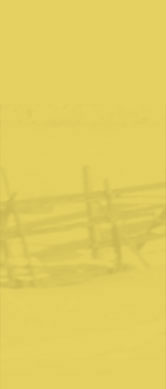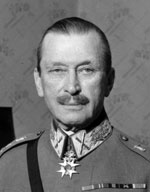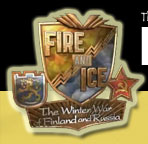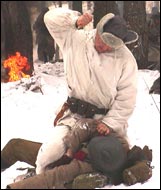

Baron Carl Gustav Mannerheim

Baron Carl Gustav Mannerheim
Finland Defence Forces Education Development Centre, Production
Division/
Photographic Section
Mannerheim was born in 1867 into a wealthy family of the Swedish ethnic minority
in the Russian province of Finland. He entered the Russian army in 1889 and
was commander of the tsar's personal army when World War I began. When Finland
declared its independence in 1917, Mannerheim returned home, organized the
White (anti-Bolshevik) army, and with German help won the short, bloody civil
war of 1918.
Regent of Finland for six months, he lost the election for president in 1919 and retired from politics. In 1931 he was put in charge of Finnish defense. He built the famous Mannerheim Line, an unsuccessful attempt to block a Soviet invasion of Finland through the Karelian Isthmus. He led Finnish forces, which were greatly outnumbered, in a brilliant battle against the USSR in the Russo-Finnish War, or the Winter War, of 1939-40. During World War II he also led Finland (in alliance with Germany) in a second war (1941-44) against the Soviets but was again defeated. Appointed marshal of Finland in 1942, he served as president from 1944 until 1946, when illness forced his retirement.
Captain Aarne Juutilainen
1904-1976
The company commander of JR34 at the battle of Kollaa he was also
known as the “Terror
Of Morocco” due to his exploits in the French Foreign Legion. Wounded three
times he was a true Finnish warrior whose name has become synonymous with the
Finnish word sisu (translates roughly to guts).
General
Woldemar Hägglund 1893-1963
A member of Jaeger Battalion 27 in World War I who became the Chief Of Staff
on the Karelian Front of the Finnish War of Independence. He was the commander
of the 2nd Division from 1934-1939 and went on to be the head of the IV Army
Corps serving from 1939-1941. He is largely linked to the “Motti” battles
that took place north of Lake Ladoga.
General Erik Heinrichs - 1890-1965
A member
of Jaeger Battalion 27 which fought for the Germans in World War
I and later became a commander in the Finnish War of
Independence. He was commander of the III Army Corp at the start
of the Winter War and later named as commander of the Army of the
Isthmus.
General Lauri Malberg 1888-1948
A member of Jaeger Battalion 27 in
World War I, Malberg returned to command the Jaeger artillery units
in the Finnish War of Independence.
He acted as the Finnish Minster of Defense in 1924 then was
the Supreme Commander of the Finnish Civil Guards from 1928-1944.
He
was also named commander of the Home Army in 1939 and served in this
post until 1945.
General Vilho Petter
Nenonen 1883-1960
Trained and served in the Imperial Russian army in the artillery branch before
his return to Finland, serving as an inspector of artillery in the Finnish Civil
War. He continued this same role in the Finnish Army for many years and is considered
the father of Finnish artillery. Nenonen was a skilled artilleryman whose methods
of fire are even today studied in various military training facilities around
the world.
General Hugo Östermann
1892-1975
Östermann attended the Swedish War College after serving in Jaeger Battalion
27 in World War I. He became commander of the Finnish Army from 1933-1939 then
was named commander of the Army of the Isthmus in 1939. He kept this position
until February 1940 when he was forced to resign after the Mannerheim Line
was broken by the Red Army. Östermann and Mannerheim often disagreed with
each other in the way they wished to command the Finnish Armed Forces and this
conflict was at times heated.
General Hjalmar
Siilasvuo 1892-1947
Served in Jaeger Battalion 27 in World War I then was a battalion
commander in the Finnish War of Independence. He became the
commander of the Finnish troops
at the victory at Suomussalmi. Known for his aggressive actions on and off
the battlefield, his personality is sometimes remembered as
much as his skills
as a battlefield commander.
General Paavo Talvela 1897-1973
As was the case with many of the
top military minds in Finland, Talvela began his military service
in World War I, serving in Jaeger Battalion
27. He later was a battalion commander in the Finnish War of Independence.
Over the years he held a number of postings in the Finnish Army including
working in Finnish HQ under Mannerheim during the start of the Winter
War. He was transferred to command Task Force Talvela in December
1939 and held this post until February 1940. He then became
commander of III Army Corps serving until April. A very good general
who was known for his aggressive actions in battle.
Aimo Cajander 1879-1943
The Prime Minster of Finland from 1937-1939. Under his term the Finnish armed
forces suffered greatly from lack of funds. At the outbreak of the Winter War
many Finnish soldiers lacked uniforms and proper equipment and had to make
due with the clothes they had on. These civilian clothes were jokingly referred
to as the Model Cajander uniform.
Simo Häyhä 1905-2001
Simo Häyhä was born in Karelia, Rautjärvi - now a
part of Russia - and at 17 he joined the Finnish Civil Guard as a
corporal in the bicycle battalion. After his
initial service he was content to join the rest of the population
for a peaceful existence; but the soviet invasion in November 1939
changed that..
Häyhä was called into action during the Winter War with
his service under the 6th Company of JR 34 on the Kollaa River. In
this battle the skills of Häyhä became legend. Before being
wounded by a Soviet sniper Häyhä killed over 500 Red
Army soldiers either using his Mosin Nagant rifle
or his
KP31 submachine gun. Häyhä is today known as one of the
greatest snipers the world has even known.
Risto Ryti 1889-1956
A lawyer by trade he was an active force in
Finnish politics for many years serving as a member of parliament.
He was named the Prime
Minster of Finland when the Winter War broke out and was later named
President of Finland in 1940. He served in this post until 1944.





